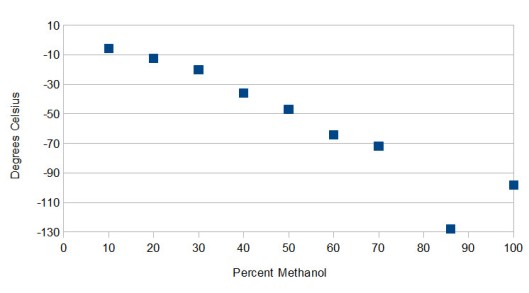Cooling your reaction to 0°C, -78°C or -196°C just requires ice, dry ice or liquid nitrogen. But how do you get to a temperature in between?
Mixed Solvent Systems: Freezing Point Depression
Most undergraduate labs use mixtures of ice and salt, which can range from -10 °C to -40 °C, depending on the ratio and type of salt. If you don’t have access to dry ice or liquid nitrogen this is probably the simplest option, though the two solids are irritating to mix and the setup can burn through surprisingly large amounts of saltYou can also use mixtures of ethylene glycol and ethanol, which are useful from -10 °C to -70 °C (depending on the proportion of ethanol). As some of my recent research required odd temperatures, I started playing around with this system. Ultimately I found that methanol/water mixtures are far more convenient and effective.
The effective cooling range of MeOH/H2O mixtures ranges from 0 °C to -128 °C (nadir at 86% methanol). Here are a few measurements I’ve made:

30% MeOH plateaus at -20 °C, 50% MeOH at -47 °C.
In my hands freezing ~10% of a 70:30 H2O:MeOH mixture wasn’t enough to shift the temperature of the bath more than a degree or so, but baths with higher methanol content were far less robust. At 50% methanol I found a ~5 °C wide plateau 7 °C below initial ice formation, which meant that the amount of dry ice had to be carefully controlled.
One caveat: These baths are best when brought to the desired temperature and monitored every 15 minutes or so. Adding a large excess of dry ice, as you would with an acetone/dry ice bath, will lead to a thick syrup that’s difficult to mix and far too cold. Ice still floats in the majority of methanol/water mixtures, but cubes will stay at the bottom of the Dewar if there is dry ice in their core.
The Other Options
If you need a constant, precise temperature a mixed solvent system just won’t work. If a cryocooler is out of your price range, the next best thing is to freeze a pure liquid. Water melts at 0 °C, but there are a lot of other chemicals in the lab, many of which are relatively inexpensive. Freeze one of them with dry ice, make up the volume with fresh solvent, and you have a quick and dirty cooling bath. Condensation will wet the bath, so if you plan on cutting costs make sure you pour the solvent into a new bottle when you’re done, not back into the communal stock.1.Over the summer one of our undergraduate students went though ~7 kg of NaCl, just making -20 °C cooling baths.
2.The exception is an 88% methanol mixture, which can be frozen solid with liquid nitrogen. Working with an 86% solution I was able to create a thick syrup of consistent temperature by rapidly stirring through freeze/thaw cycles.
3.The wikipedia page on cooling baths is surprisingly comprehensive. Check there for specific freezing points.







No comments:
Post a Comment